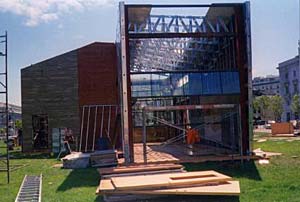Green Day
Air Date: Week of June 3, 2005

Volunteers put the final touches on the Scraphouse. (Photo: Eileen Bolinsky)
Organizers of World Environment Day in San Francisco want to show international delegates a concrete example of how to “green” a city. The Scraphouse is a model home built entirely of reclaimed and recycled material, and designers say it is poignant symbol of reuse from refuse. Laurence Kornfield, city building inspector tours the Scraphouse in this sound portrait.
Transcript
CURWOOD: World Environment Day is really a multi-day long event, with San Francisco touting its delicious food and wonderful scenery, along with highlighting its environmental achievements with exhibits, panels and tours. Among the innovations on display: next-generation solar panel arrays, vehicles powered by hydrogen fuel cells, and an unusual structure dubbed "The Scraphouse." This model home, erected among the Beaux Arts splendor of the San Francisco Civic Center, was constructed entirely of reclaimed and recycled materials that might otherwise be taking up space in a landfill. Designed and built in just over a month by more than 80 volunteers, the home serves as a steel, wood and glass example of how items usually discarded as junk could have a new lease on life. Laurence Kornfield, the city's chief building inspector, took us on a tour of the Scraphouse.
[KORNFIELD WHISTLING, SOUNDS OF DRILLING, CONSTRUCTION]

All the material used in building the Scraphouse came from salvage yards, dumps, or waste piles at active construction sites. (Photo: Eileen Bolinsky)
KORNFIELD: So let me show you. Come on in and take a look inside. Although really, watch your step here, this is a real hazard. Heads up here, heads up.
[SOUNDS OF DRILLING, CONSTRUCTION]
KORNFIELD: We have a large crew of scrap mongers, scrap salvagers out around the city now. Some of them are here volunteering, but we’re out scavenging. We did a bus tour in that big old green tortoise bus over there around the city with a design team one of the first weeks we were working on this and we went to all the scrap yards and all the junk yards just to get a feel for what was in the waste stream and it was phenomenal the stuff we saw.
[ENGINE REVVING]
KORNFIELD: This is extra glazing from the construction process which ordinarily would just go into the rebox to the landfill. The siding is the stuff that looks like it came out of your, my grandfather’s smoking lounge in the basement of his house in Philadelphia in the ‘50s and it was at the back of some warehouse. So it’s all entirely reclaimed scrap material.
[DRILLING]
KORNFIELD: The structure is metal studs which came out of old tenant improvement and other construction jobs in San Francisco. It’s all patched together, but you know structurally it works if it’s put together right.
[DRILLING]
KORNFIELD: They’re bringing in the leather for the floor.
BLUMENFELD: There’s going to be a leather floor?
|
KORNFIELD: There’s a leather floor in the bedroom I understand. And uh, yeah, it’s just, it’s amazing. It will have a large table in the living room, an artist is making out of cardboard, recycled cardboard. BLUMENFELD: Huh. KORNFIELD: Which apparently is what his medium is. It’s more than just a one-shot deal. We have to take this and somehow translate it into our daily practices, both at the city and in the construction industry. VOLUNTEER: Thanks you guys, thanks Jean. BLUMENFELD: The real lesson is whether you’re building a tree house or an addition or a garage or, you can go and find cool found objects. It’s a house made from scraps. Links
|






